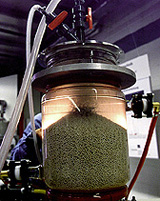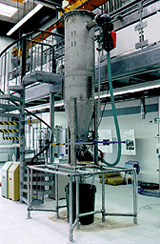The design of this type of reactor depends upon the flow properties of the fixed bed packing. Available particles are differing in their characteristics as follows: availability, immobilization of microorganisms, mechanical stability, flow properties and conveying properties. The identification of the flow properties of the particles is basically founded on the theory of flow of bulk solids. The measuring of the relevant characteristics of the flow properties is performed in shear cells. In this way the so called yield locus and wall friction of the bulk solid (fixed bed) are determined.
With respect to the design of fixed bed reactors the following terms are to be determined: the slope angle of the hopper and the critical area at which no blocking of the flowing particles occurs. By this way, mass flow is achieved and the whole fixed bed is flowing at once. Funnel flow should be avoided. The process-technological tests are virtually finalized. The first prototypes are in operation for biotechnological processes at industrial companies.
 Fraunhofer Institute for Interfacial Engineering and Biotechnology IGB
Fraunhofer Institute for Interfacial Engineering and Biotechnology IGB
